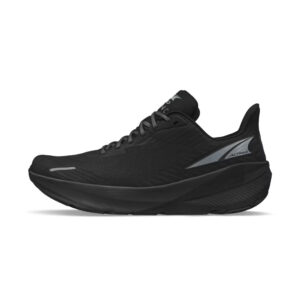In the previous blog, we discussed the importance of zero drop shoes. Now we will cover the important concept of ‘neutral’ shoes. A neutral shoe refers to one that is not build for a person who is flat footed (pes planus) or who has a high argh (pes cavus). It is literally neutral, and this is good.

The Altra FWD is a zero drop shoe with a 4mm heel to toe drop. It is currently my favorite running shoe.
They are made to allow your foot to strike the ground as it was meant. Most shoes, if not neutral, will be marked as ‘stability’ or ‘motion control.’ A stability/motion control shoe is angled so as to go against your over-pronated foot and simply turn your foot out a bit. Simple enough, right? Sure, but it’s made for the masses. Is your foot the same as the millions of other who are wearing that shoe to correct a generalized problem? Not likely. For those who are flat-footed, you still want a neutral shoe and you’ll want a proper orthotic to match your unique foot!
The issue with shoes and those who pronate is that there is no individuality. Is the person’s flat-footedness due to not having an arch or a true foot/ankle deformity? Many people think they need this type of shoe because they are flat footed. Although a ‘flat foot’ leads to internal lower extremity rotation and a large amount of gait issues, simply sticking a slanted shoe under the foot is not a great solution. However, this is what shoe companies do. We can do better!

The Hoka Clifton is a neutral drop shoe with a 5mm heel to toe drop. Questions about quality now exist due to the brand becoming mass-produced.
The uniqueness of our feet need to be addressed in a unique fashion. Those stability and motion control shoes are just too generic for those of us who want optimal function. The best idea is to address the flat foot to see if it is a structural or functional problem, and treat accordingly. This will require the input of someone who is trained in foot biomechanics and gait.
As previously stated, individualized orthotics in a zero drop, neutral shoe will be the best way to go. We have already discussed the importance of zero or near zero drop shoes in the previous blog and once we have a pair of these, that are also neutral, we can address the individual foot to see if an orthotic is necessary.
Being there are no studies proving that an $800.00 orthotic is any better than a $100.00 one, what do we need to look for when we are assessing orthotics to aid with with pronation issues? Technically, to decide if an orthotic is necessary, the foot should be assessed in a neutral talonavicular position. This assures proper alignment and loading. This is the way the bones stack when we are ambulating. The orthotic is then crafted addressing the found pathology.
The orthotic also needs to consider the specific athletic need. Runners and lacrosse players have different foot movements and whereas typically constructed orthotics may be good for runners, who are only moving in the sagittal plane, they won’t work well for athletes who are cutting and changing directions.

The Altra Torin is both neutral and has a zero drop.
Some orthotics are made with a texture for grip and some are made with extra padding for impact, etc… Most importantly, the orthotic needs to support the arch and correct for any inversion/eversion (foot turned in or out). Should we achieve these objectives, this will more than suffice for most of the correction for the vast majority of people. To summarize, if you have a flat foot, don’t just get a shoe that tilts your foot outward (literally). Go with a shoe that we all need: neutral. Then add an orthotic that is specific for your foot.
Remember that although walking only drops 1-3x your bodyweight with every step, jogging is 3-5x, running 5-7x, and jumping can be about 10x your body weight with every jump. In addition, research shows that for every pound of weight we are above an ideal weight, there is an increase of loading on the knee with every step by 3-4 times. This is a tremendous amount of additional pressure.
Energy is transmitted up the feet through the lower extremity to the pelvis, low back ,etc. If we are not dealing with ground reactive forces properly, we are going to pay the price sooner, or later. Why wait until later? Get proper shoes that are neutral and zero drop, use an individualized orthotic, and help your body function at an optimal level going forward!
Don’t Be a Meathead is protected by Copyright laws. If you wish to post any content from www.dontbeameathead.com, you must obtain express (written…this can be email) permission before doing so. We love sharing important information to help people and we do appreciate your respect for our intellectual property.





